Sony EE34: Sony Makes Budget AMD Laptops?
by Dustin Sklavos on February 22, 2011 4:43 PM ESTNot Fast, But Fast Enough
Historically we've been pretty underwhelmed with AMD's mobile offerings, barring maybe the Turion II Neo and now Brazos. These aren't bad chips, but if AMD's been struggling to play catch-up on the desktop they've been left miles behind in notebooks where power and heat become ever more important.
With that said, though, the 25W, 2.2GHz Athlon II P340 dual-core processor isn't a particularly bad chip either. Inheriting the K10.5 architecture from its desktop siblings, it at least offers a good bump over older K8-based chips and is capable of handling most of the tasks you're liable to throw at it.
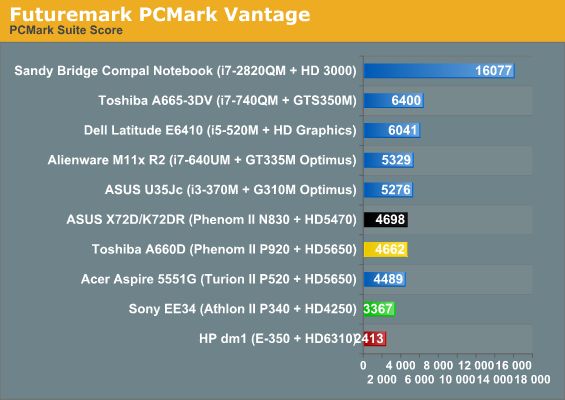
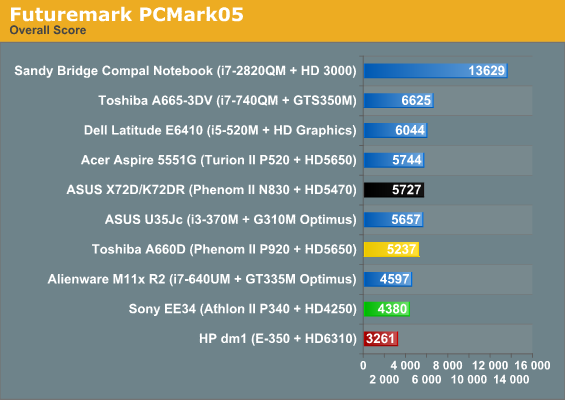

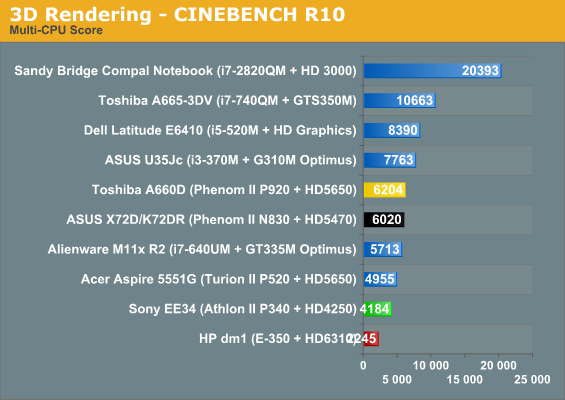
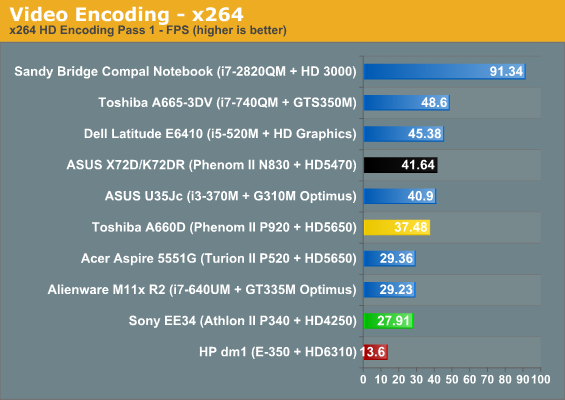
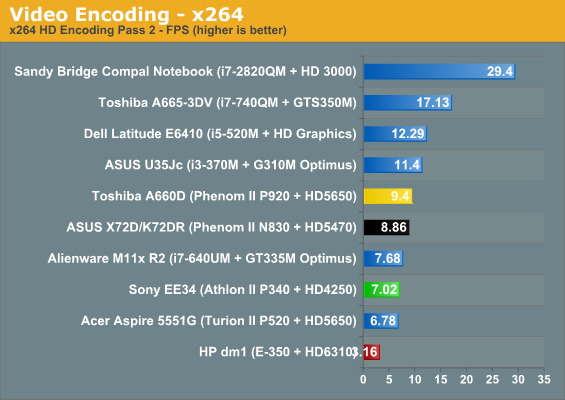
Before we get too far in analyzing these results, it's important to note that our usual x264 benchmark refused to run on the EE34 and would always crash at exactly the same point. This occurred whether on the factory install or on a clean installation of Windows 7, and it's the only time we've ever seen this happen. The EE34 completed all our other tests perfectly fine and was nice and stable in regular use, but it bears mentioning that for the x264 results we did have to simulate the processor using a desktop Athlon II X4 with two cores disabled and the clocks adjusted. I'm confident that these scores are within the ballpark for what you could expect from the Athlon II P340, but they bear mentioning nonetheless.
Comparing against the other AMD processors in the lineup, the P920 is a quad-core chip running at 1.6GHz while the N830 is a tri-core chip running at 2.1GHz. So with that in mind, the tri-core running at 100MHz slower than the P340 in the EE34 seems like it's probably the best compromise, but the P340 doesn't put in an awful showing either. All of the AMD chips are more or less dwarfed by their Intel rivals, but it's not a complete bloodbath. For reference we've included the E-350's scores so you can see what bumping up to even a slower full-sized AMD notebook can get you.
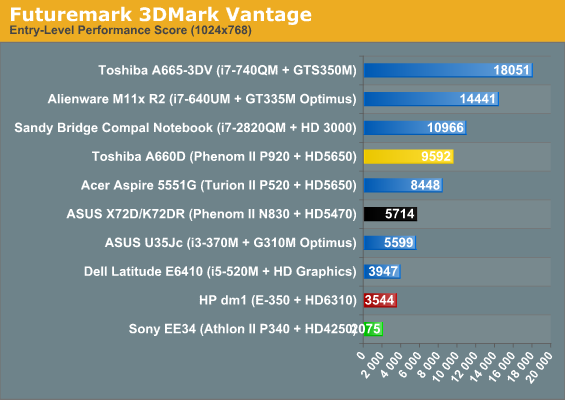
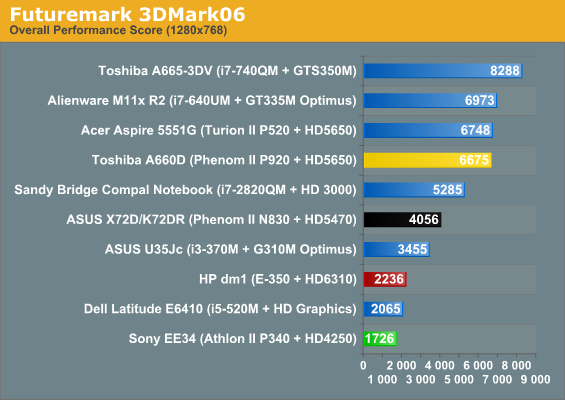
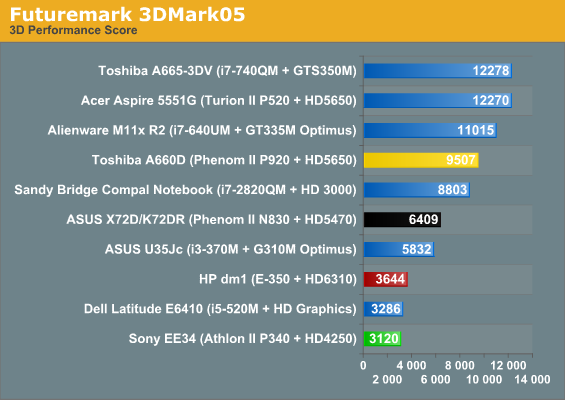

Unfortunately the 3DMark tests bear out just how poorly AMD's 40-shader IGP has aged. The E-350 beats it at every turn and even the utterly anemic GeForce 310M is a substantial improvement. While Llano's CPU performance doesn't promise to be a substantial improvement over what we've seen here (the cores are basically K10.5), the integrated graphics should at least be a big enough boost to make it a very compelling mobile part. Hopefully between Brazos, Llano, and Sandy Bridge, the era of poor integrated graphics can finally come to a close.










52 Comments
View All Comments
Akv - Wednesday, February 23, 2011 - link
What a bombasticly huge mistake, adding a blu-ray player in a budget laptop...I never buy blu-ray disks, and the only use I have for classic DVD drives is installing software, very rarely.
Silver47 - Tuesday, February 22, 2011 - link
Hi DustinI work on the electrical department in Tescos here in the UK ( sort of our Wall Mart) and we sell the Sony Vaio EE3E which has a similar configuration. It doesn't have the bluray drive and a gig less of RAM all yours for £499 (~$800). When I first saw the spec and pictures I thought how could you not of seen a budget Vaio before, we have had this one for some time (though granted the EE34 is waaaaaay better value to what we have). I would of thought you would of had something like this in the US most of the time?
Anyway heres a pic of the mythical beast http://twitpic.com/42pmjv/full and personally I thought it was one of the better built laptops we have (this is the most expensive one we stock, if you hate crappy displays you'll have a heart attack in here ;) )
Silver
Taft12 - Tuesday, February 22, 2011 - link
Dustin, I think this was one of your best AT articles yet, and it wasn't a very interesting product - I think that speaks well to your improving writing skills.My cousin's wife got a Samsung laptop that was maybe $100 less with no Bluray and the same CPU -- I found myself impressed with the quality of the build compared to low-end Acer and HP, and the battery life was excellent.
I didn't believe it could be true, but the 25W Athlon CPUs really nail the niche they set out to fill - a middle-of-the-road balance between performance and battery life.
GullLars - Tuesday, February 22, 2011 - link
Since you note to begin this laptop has a crappy HDD, i would love to see what potential it holds if you put an SSD in it. Some of us are now moving to our second or third round of SSDs, and may have one left over, or consider purchasing one specifically as an upgrade.Also, this notebook has an 8xx chipset, which means it SHOULD support 6Gbps.
Why not test it with a C300 64GB, and/or the Vertex 3 256GB (a PCmark Vantage run would be more than enough to really put a smile on my face)
mino - Tuesday, February 22, 2011 - link
This was a system review, not a platform review. AMD's mobile platform performance is no secret so fitting even RAMdribe in it is not worth the effort.On the other hand a nice 320G WD Black drive would up the cost about $10 while providing a sensible benefit.
Putting in a basic 80G SSD would destroy its value proposition not to mention even more showing its IGP and CPU bottlenecks.
cfaalm - Wednesday, February 23, 2011 - link
Agreed, just put in the WD320 Scorpio. Even if you buy it afterwards, it would still be a good investement if you also buy a 2.5" external USB housing and place the original Toshiba in there. Nothing goes to waste. I upgraded my 2007 MacBook this way.nitrousoxide - Wednesday, February 23, 2011 - link
I changed both of my laptops with SSDs, and the 2 HDDs put in RAID 0 on my PC. They are slow 5400rpm laptop drives but very fast in RAID :)7Enigma - Friday, February 25, 2011 - link
For some of the early adopters of SSD technology and also for people that upgrade frequently we are just about at the point where some enthusiasts might be on their 2nd or 3rd SSD. That creates the time where some people will have second-hand SSD's from say 1st gen tech (Intel 1st gen or, horror, JMicron 1st gen) and basically do this upgrade for "free".I know not everyone (or even a majority), but there are those out there that have this as a viable option. Me, for instance, has an 80GB second gen (G2) Intel drive that has been fantastic for the last year and a half. More so than needing a speed boost I want to get one for my laptop that I carry around the house (with it's anemic 5400rpm drive).
I could see buying a great 3rd gen SSD for my desktop and migrating the 80GB Intel over to my old laptop, and that is a scenario I see becoming commonplace in the near future.
Just a thought....
jabber - Tuesday, February 22, 2011 - link
Especially a cheap one. If you get 4 years then any laptop has done its job. Time to get a new one thats twice as fast and half the price again.Commodity items. I'd never spend more than £500 on a laptop ever again. Just a tool to use and abuse.
You spend £800+ on a uber laptop and you are always worrying you are going to crack it, scratch it etc.
With a cheap laptop in a ABS type plastic case no worries. The Lenovo G550 series are a prime example of good day to day knock about laptops.
mino - Tuesday, February 22, 2011 - link
I spend $1000 average on a laptop because I need it to work. Daily. And it is cheaper than spending twice $600.Not to mention much more enjoyable working on a not-crappiest LCD/chassis/KB/touchpad/webcam/WAN/BT/Wifi/eSATA/USB3 configuration ...